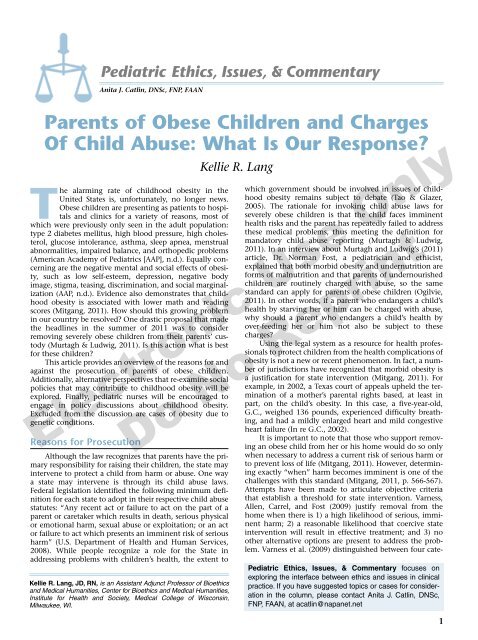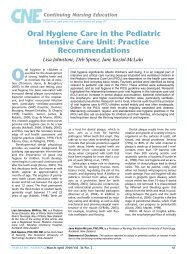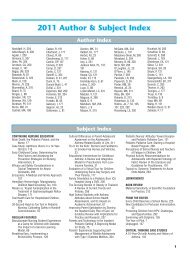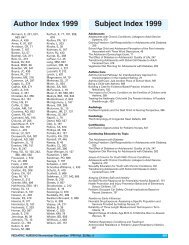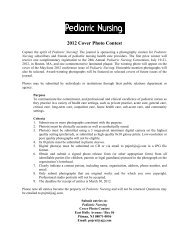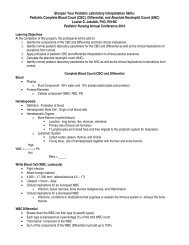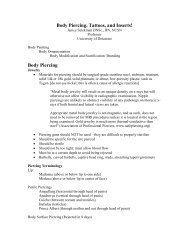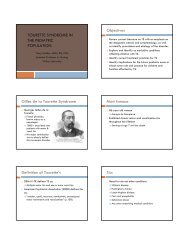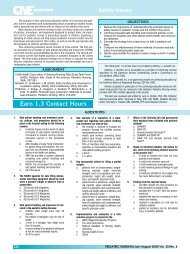2 Column Dept - Pediatric Nursing
2 Column Dept - Pediatric Nursing
2 Column Dept - Pediatric Nursing
You also want an ePaper? Increase the reach of your titles
YUMPU automatically turns print PDFs into web optimized ePapers that Google loves.
<strong>Pediatric</strong> Ethics, Issues, & Commentary<br />
Anita J. Catlin, DNSc, FNP, FAAN<br />
Parents of Obese Children and Charges<br />
Of Child Abuse: What Is Our Response?<br />
The alarming rate of childhood obesity in the<br />
United States is, unfortunately, no longer news.<br />
Obese children are presenting as patients to hospitals<br />
and clinics for a variety of reasons, most of<br />
which were previously only seen in the adult population:<br />
type 2 diabetes mellitus, high blood pressure, high cholesterol,<br />
glucose intolerance, asthma, sleep apnea, menstrual<br />
abnormalities, impaired balance, and orthopedic problems<br />
(American Academy of <strong>Pediatric</strong>s [AAP], n.d.). Equally concerning<br />
are the negative mental and social effects of obesity,<br />
such as low self-esteem, depression, negative body<br />
image, stigma, teasing, discrimination, and social marginalization<br />
(AAP, n.d.). Evidence also demonstrates that childhood<br />
obesity is associated with lower math and reading<br />
scores (Mitgang, 2011). How should this growing problem<br />
in our country be resolved? One drastic proposal that made<br />
the headlines in the summer of 2011 was to consider<br />
removing severely obese children from their parents’ custody<br />
(Murtagh & Ludwig, 2011). Is this action what is best<br />
for these children?<br />
This article provides an overview of the reasons for and<br />
against the prosecution of parents of obese children.<br />
Additionally, alternative perspectives that re-examine social<br />
policies that may contribute to childhood obesity will be<br />
explored. Finally, pediatric nurses will be encouraged to<br />
engage in policy discussions about childhood obesity.<br />
Excluded from the discussion are cases of obesity due to<br />
genetic conditions.<br />
Reasons for Prosecution<br />
Although the law recognizes that parents have the primary<br />
responsibility for raising their children, the state may<br />
intervene to protect a child from harm or abuse. One way<br />
a state may intervene is through its child abuse laws.<br />
Federal legislation identified the following minimum definition<br />
for each state to adopt in their respective child abuse<br />
statutes: “Any recent act or failure to act on the part of a<br />
parent or caretaker which results in death, serious physical<br />
or emotional harm, sexual abuse or exploitation; or an act<br />
or failure to act which presents an imminent risk of serious<br />
harm” (U.S. Department of Health and Human Services,<br />
2008). While people recognize a role for the State in<br />
addressing problems with children’s health, the extent to<br />
Kellie R. Lang<br />
which government should be involved in issues of childhood<br />
obesity remains subject to debate (Tao & Glazer,<br />
2005). The rationale for invoking child abuse laws for<br />
severely obese children is that the child faces imminent<br />
health risks and the parent has repeatedly failed to address<br />
these medical problems, thus meeting the definition for<br />
mandatory child abuse reporting (Murtagh & Ludwig,<br />
2011). In an interview about Murtagh and Ludwig’s (2011)<br />
article, Dr. Norman Fost, a pediatrician and ethicist,<br />
explained that both morbid obesity and undernutrition are<br />
forms of malnutrition and that parents of undernourished<br />
children are routinely charged with abuse, so the same<br />
standard can apply for parents of obese children (Ogilvie,<br />
2011). In other words, if a parent who endangers a child’s<br />
health by starving her or him can be charged with abuse,<br />
why should a parent who endangers a child’s health by<br />
over-feeding her or him not also be subject to these<br />
charges?<br />
Using the legal system as a resource for health professionals<br />
to protect children from the health complications of<br />
obesity is not a new or recent phenomenon. In fact, a number<br />
of jurisdictions have recognized that morbid obesity is<br />
a justification for state intervention (Mitgang, 2011). For<br />
example, in 2002, a Texas court of appeals upheld the termination<br />
of a mother’s parental rights based, at least in<br />
part, on the child’s obesity. In this case, a five-year-old,<br />
G.C., weighed 136 pounds, experienced difficulty breathing,<br />
and had a mildly enlarged heart and mild congestive<br />
heart failure (In re G.C., 2002).<br />
It is important to note that those who support removing<br />
an obese child from her or his home would do so only<br />
when necessary to address a current risk of serious harm or<br />
to prevent loss of life (Mitgang, 2011). However, determining<br />
exactly “when” harm becomes imminent is one of the<br />
challenges with this standard (Mitgang, 2011, p. 566-567).<br />
Attempts have been made to articulate objective criteria<br />
that establish a threshold for state intervention. Varness,<br />
Allen, Carrel, and Fost (2009) justify removal from the<br />
home when there is 1) a high likelihood of serious, imminent<br />
harm; 2) a reasonable likelihood that coercive state<br />
intervention will result in effective treatment; and 3) no<br />
other alternative options are present to address the problem.<br />
Varness et al. (2009) distinguished between four cate-<br />
Electronic Use Only<br />
Kellie R. Lang, JD, RN, is an Assistant Adjunct Professor of Bioethics<br />
and Medical Humanities, Center for Bioethics and Medical Humanities,<br />
Institute for Health and Society, Medical College of Wisconsin,<br />
Milwaukee, WI.<br />
Do No Reprint<br />
<strong>Pediatric</strong> Ethics, Issues, & Commentary focuses on<br />
exploring the interface between ethics and issues in clinical<br />
practice. If you have suggested topics or cases for consideration<br />
in the column, please contact Anita J. Catlin, DNSc,<br />
FNP, FAAN, at acatlin@napanet.net<br />
1
<strong>Pediatric</strong> Ethics, Issues, & Commentary<br />
gories of obese children, depending upon the presence of<br />
co-morbidities that predict serious harm and whether these<br />
are reversible in adulthood, or whether these constitute<br />
imminent harm in childhood. State intervention would be<br />
justified when the co-morbid conditions predict serious<br />
harm and are not reversible in adulthood, as well as when<br />
the co-morbid conditions constitute serious harm in childhood<br />
(Varness et al., 2009).<br />
Citing concerns for bias and conjecture in reaching a<br />
decision about obesity as child abuse, Mitgang (2011)<br />
underscored the importance of objective, physical evidence<br />
in an abuse analysis. She would justify state intervention<br />
when necessary to prevent loss of life or to address a current<br />
risk of serious harm and only after home-interventions had<br />
failed (Mitgang, 2011). Mitgang (2011) identified four factors<br />
that should be used by a court in determining whether<br />
actual medical harm caused by the child’s obesity warrants<br />
state intervention:<br />
• The severity of child’s illness associated with obesity.<br />
• The degree in which medical treatment can mitigate<br />
the resulting health effects.<br />
• The child’s complete physical and mental health picture.<br />
• When the just answer is unclear, the child’s risk of<br />
remaining obese as an adult.<br />
Response to Murtagh and Ludwig<br />
As one would expect, Murtagh and Ludwig’s (2011)<br />
article was met with a strong response from the medical<br />
and legal communities. Each of these three letters to the<br />
editor, including Ludwig and Murtagh’s response, will be<br />
discussed in turn.<br />
Ms. Carol Erskine, a justice in a Massachusetts county<br />
juvenile court, wrote to underscore that in these cases, state<br />
intervention may occur only under clearly defined legal<br />
parameters (Erskine, 2011). The state has to meet the burden<br />
of proof required to disrupt the privacy rights of the<br />
family; the mere suggestion of state intervention does not<br />
change the state’s actual burden (Erskine, 2011). Ludwig<br />
and Murtagh (2011) agreed with Ms. Erskine in their<br />
response to her letter and indicated their intent was to work<br />
within the existing legal structure, not to change it.<br />
Robert Siegel (staff physician for the Northern<br />
Kentucky Children’s Advocacy Center) and Thomas Inge<br />
(director of the Surgical Weight Loss Program for Teens &<br />
Center for Bariatric Research) took issue with Murtagh and<br />
Ludwig’s (2011) suggestion, stating that it might be unethical<br />
for an obese child to undergo bariatric surgery without<br />
first considering foster care (Siegel & Inge, 2011). For these<br />
physicians, weight-loss surgery and social service intervention<br />
are mutually exclusive (Siegel & Inge, 2011). Suitable<br />
candidates for this surgery would not be appropriate candidates<br />
for state intervention, and children under consideration<br />
for social service referral would not be appropriate candidates<br />
for surgery (Siegel & Inge, 2011). They explained<br />
that any family that met the Varness et al. (2009) criteria for<br />
state intervention would not meet the best-practice criteria<br />
for weight-loss surgery (Siegel & Inge, 2011). They also cited<br />
evidence that foster care may, in fact, be an obesogenic<br />
environment (Siegel & Inge, 2011). Ludwig and Murtagh<br />
(2011) responded to this criticism by noting that there are<br />
children who fall in between these categories, where they<br />
experience inadequate parenting that does not meet the<br />
legal definition of neglect.<br />
2<br />
Finally, Drs. Susan Yanovski, Jack Yanovski, and Mary<br />
Horlick (2011) noted that Murtagh and Ludwig’s (2011)<br />
article held two false assumptions: 1) severe childhood obesity<br />
necessarily resulted from poor parenting rather than<br />
genetics, and 2) type 2 diabetes requires removal from the<br />
home, and foster care is beneficial to obesity treatment.<br />
These authors argued that there is no evidence that foster<br />
families control the weight of obese children better than<br />
the children’s families of origin, and that greater social<br />
resources should be provided to parents of obese children<br />
so that medical complications can be prevented or treated<br />
within their own homes (Yanovski, Yanovski, & Horlick,<br />
2011). Ludwig and Murtagh (2011) responded that they<br />
recognized genes affect weight and that foster care would<br />
not be appropriate for most severely obese children, noting<br />
that the primary treatment for type 2 diabetes is lifestyle<br />
modifications and weight loss. While they agreed the foster<br />
care program should receive greater scrutiny, they also<br />
noted one case where a young teenager died while waiting<br />
for custody hearing (Ludwig & Murtagh, 2011). Finally,<br />
Ludwig and Murtagh (2011) agreed that greater resources<br />
should be provided but raised the practical question of who<br />
would actually provide those resources. They conclude that<br />
in the interim, existing resources that would preclude the<br />
need for foster care or bariatric surgery should be used<br />
(Ludwig & Murtagh, 2011).<br />
Additional Reasons Against Prosecution<br />
Other reasons to oppose the removal of obese children<br />
from their homes stem from a broad range of concerns.<br />
These include 1) severe emotional or psychological harm to<br />
the child, especially in light of the lack of evidence that foster<br />
care for these children is effective “treatment;” 2) inconsistencies<br />
in the legal process that might lead to unfair outcomes;<br />
and 3) a social and political landscape that arguably<br />
has a net effect of promoting childhood obesity.<br />
Lack of Evidence about Foster Care<br />
And Potential for Harm<br />
A more compelling argument against prosecution of<br />
parents is the most glaring: the lack of evidence regarding<br />
the effectiveness of protective custody or foster care<br />
(Diekema, 2011; Siegel & Inge, 2011; Yanovski et al., 2011).<br />
Diekema (2011), a pediatrician and ethicist, argued that<br />
without any evidence of its effectiveness, removing a child<br />
from her or his home should not be a mechanism used to<br />
treat childhood obesity. As a correlating factor, Diekema<br />
(2011) called attention to the significant psychological<br />
harm experienced by a child when removed from the<br />
home, and noted that this must be considered in any protective<br />
custody decision. This is compounded by a concern<br />
that some foster homes may not offer a nurturing environment.<br />
It is interesting to note that even those who support<br />
state intervention have cited concerns about the quality of<br />
foster care (Murtagh & Ludwig, 2011). Without evidence<br />
that the potential benefit of removing an obese child from<br />
her or his home outweighs the harm of doing so, the disruption<br />
of a family relationship cannot be justified<br />
(Diekema, 2011).<br />
Electronic Use Only<br />
Do No Reprint<br />
Potential for Unfair/Disparate Impact<br />
Another concern is the very real possibility that the<br />
interpretation of criteria to remove children from families<br />
may vary between different communities and jurisdictions
that result in, albeit unintended, negative social consequence.<br />
For example, a New York trial court agreed with the<br />
Department of Social Services and found that parents of an<br />
obese girl were unwilling to comply with a court order to<br />
ensure that the child attended school, gym, and other<br />
activities. However, the parents appealed this decision, and<br />
the appeals court found there was a lack of evidence that<br />
the parents had not complied with the court order (In re<br />
Brittany, 2008). It is disturbing to consider the injustice of<br />
what might have happened had the parents not appealed<br />
the initial decision. Compounded to these questions of fairness<br />
is the concern that state action may result in a disproportionate<br />
impact on minority families because minority<br />
children in the United States are disproportionately represented<br />
in overweight/obese statistics (Mitgang, 2011).<br />
The Role of Society in Childhood Obesity<br />
A final reason for opposing prosecution of parents is<br />
that it is unfair to place the blame solely on parents when<br />
society has also played a role in the obesity epidemic. Our<br />
modern environment encourages a sedentary lifestyle<br />
through limited outdoor and unstructured activity opportunities;<br />
an increased reliance on automobiles for transportation;<br />
increased use of television, video, and other<br />
technology as entertainment; and less meals prepared with<br />
fresh foods at home (Brody, 2011). Although parents are<br />
responsible for their children, they do not have control<br />
over their child’s behavior inside or outside the home<br />
(Diekema, 2011). Parents do not raise their children in a<br />
vacuum; our environment in tandem with social policies,<br />
especially regarding marketing and school lunches, can<br />
have a powerful influence on family health. In looking at<br />
childhood obesity then, a wider lens must be incorporated<br />
that includes an examination of the social and political<br />
landscape that so strongly influences our culture. To illustrate<br />
this landscape and demonstrate the general public’s<br />
concern about childhood obesity, this author will include<br />
citations from general public, or non-medical, resources.<br />
In the summer of 2011, there were two national initiatives<br />
targeted toward addressing the country’s obesity epidemic.<br />
First Lady Michelle Obama brought the issue of obesity<br />
to national attention with the “Let’s Move” campaign<br />
(Let’s Move, 2011). Second, the United States Department<br />
of Agriculture launched its new food icon MyPlate (Vilsack,<br />
2011) that replaced the food pyramid with the goal of helping<br />
consumers choose healthier food options. These recent<br />
public education initiatives are helpful, but unfortunately,<br />
cannot counter the effects, past and present, of the food<br />
marketing industry.<br />
Food and beverage marketing is very effective among<br />
children and is associated with increasing obesity rates<br />
(Brody, 2011). Food advertisements on television watched<br />
by children promote products high in fat, sugar, or sodium<br />
(Harris & Graff, 2011). Research has revealed that food marketing<br />
affects children’s brand and specific food preferences,<br />
and has demonstrated an association between soft<br />
drink advertising, specifically, and consumption of sugarsweetened<br />
drinks (Harris & Graff, 2011). The obesity crisis<br />
cannot be solved without significant changes to the marketing<br />
environment that surrounds children (Harris &<br />
Graff, 2011). Although the food industry has taken some<br />
self-regulatory steps to address advertising concerns, the<br />
fine-print reveals that these steps are fraught with exclusions<br />
and limitations that will not improve existing marketing<br />
practices (Harris & Graff, 2011).<br />
Additionally, national social programs contribute to<br />
unhealthy diet in school children. The National School<br />
Lunch Program, originally intended to provide healthy<br />
meals to children regardless of income, was also designed to<br />
subsidize agribusiness, such as beef and dairy (Yeoman,<br />
2003). As a result, critics of the program argue school lunches<br />
contain too much fat, additives, and preservatives and<br />
not enough vegetables (Parker-Pope, 2009; Yeoman, 2003).<br />
In fact, a group of retired generals, called “Mission:<br />
Readiness,” has even advocated for healthier school lunches<br />
and described the current program as a national security<br />
issue, citing obesity as the leading medical disqualifier for<br />
military service (Mission: Readiness, 2011). In spite of the<br />
growing national concern for childhood obesity, Congress'<br />
initial reaction to regulatory changes, which would have<br />
made school lunches healthier, was a refusal to accept these<br />
changes (Nixon, 2011).<br />
Despite the national attention to the public health<br />
concern of childhood obesity, the public does not seem to<br />
have reached a consensus as to whether our elected officials<br />
should control the conditions of the sale of some foods,<br />
restrict advertising of certain foods, subsidize healthier<br />
alternatives, and restrict or ban certain ingredients (Kersh,<br />
Stroup, & Taylor, 2011). The American Nurses Association<br />
has taken note of this as well. “While the effects of previous<br />
policies that have contributed to decreased physical activity<br />
and increased intake of ‘empty calories’ are beginning to<br />
be acknowledged in public policy debates, current policy<br />
initiatives are more likely to focus on individual choices<br />
than sweeping economic and social changes” (Tao &<br />
Glazer, 2005).<br />
The social policy contributions to obesity may seem<br />
daunting, but several first-steps have been proposed. The<br />
Robert Wood Johnson Foundation has funded evidencebased<br />
interventions and made efforts at community, state,<br />
and federal levels to advance the following policy priorities:<br />
1) ensure all food/beverages served and sold in schools<br />
meet or exceed the Dietary Guidelines for Americans; 2)<br />
increase access to affordable foods through new or<br />
improved grocery and corner stores that sell more healthful<br />
foods; 3) increase time, intensity, and duration of children’s<br />
physical activity at and out of school; 4) use pricing strategies<br />
(incentives and disincentives) to promote the purchase<br />
of healthier foods; and 5) reduce exposure to marketing of<br />
unhealthy foods through regulation, policy, and effective<br />
industry self-regulation (Govea, 2011; Kersh et al., 2011).<br />
Other suggested interventions include controlling the conditions<br />
of sale, subsidizing healthy foods that are frequently<br />
more expensive, and restricting certain ingredients<br />
(Kersh et al., 2011).<br />
When industry practices render a significant negative<br />
effect on the health of a country’s citizens, especially their<br />
most vulnerable, and when these industries do not voluntarily<br />
make changes; then all levels of government are obligated<br />
to intervene where they are able (Harris & Graff,<br />
2011). It is disheartening to note on one hand, the apparent<br />
willingness of our society to prosecute individual parents<br />
for childhood obesity and accept those social costs,<br />
monetary and otherwise; and yet, on the other hand, be<br />
unwilling to take steps that would help to prevent childhood<br />
obesity in the first place. Diekema (2011) notes the<br />
irony of a country that allows removing obese children<br />
from their homes but that does not support healthier children<br />
through controlled advertising, legislating a living<br />
wage, or making healthy foods affordable. A responsibility<br />
Electronic Use Only<br />
Do No Reprint<br />
3
<strong>Pediatric</strong> Ethics, Issues, & Commentary<br />
of government is to promote public health, especially for<br />
children (Harris & Graff, 2011). If the state is allowed to<br />
remove an obese child from her or his home, it should also<br />
be required to advance sound, consistent health policies<br />
that promote the health of children.<br />
Role of <strong>Pediatric</strong> Nurses<br />
Nurses are privileged to hold the public’s trust (Jones,<br />
2010), and as such, it is important for them to thoughtfully<br />
and critically think about the social conditions and public<br />
policies that have profound effects on health. The<br />
Nurses Code of Ethics mandates that nurses promote and<br />
advocate and work to protect the health and rights of<br />
patients, collaborate with others to promote efforts to meet<br />
health needs, and shape social policy (American Nurses<br />
Association, 2001). Because pediatric nurses care for children<br />
who live within a broad range of family and social situations,<br />
they must be comprehensive in their approach to<br />
addressing the problem of childhood obesity. Does the<br />
adversarial process of removing obese children from their<br />
homes benefit children in the short or long term? Does the<br />
practice (or threat of) removing obese children from their<br />
homes serve as a deterrent to other parents who may raise<br />
obese children? Do clinics and hospitals, in practice, support<br />
healthy food choices for their patients? Do health care<br />
providers and organizations actively encourage laws that<br />
will protect or ensure children’s health? Do we elect representatives<br />
that introduce or support these laws? As public<br />
health professionals, patient advocates (Tao & Glazer,<br />
2005), and participants in a democracy, nurses can influence<br />
public discussion and initiate solutions that benefit<br />
the whole child.<br />
References<br />
American Academy of <strong>Pediatric</strong>s (AAP). (n.d.). About childhood obesity.<br />
Retrieved from http://www.aap.org/obesity/about.html<br />
American Nurses Association (ANA). (2001). Code of ethics for nurses<br />
with interpretative statements. Retrieved from http://nursingworld.org/codeofethics<br />
Brody, J. (2011, September 12). Attacking the obesity epidemic by first<br />
figuring out its cause. The New York Times. Retrieved from<br />
http://www.nytimes.com/2011/09/13/health/13brody.html?pagewanted=all<br />
Diekema, D. (2011). Reasons to think twice before calling CPS about<br />
morbid obesity. AAP Grand Rounds, 26, 48.<br />
Erskine, C. (2011). Letter to the editor. Journal of the American Medical<br />
Association, 306(6), 1762-1763.<br />
Govea, J. (2011). Ethical concerns regarding interventions to prevent<br />
and control childhood obesity. Preventing Chronic Disease, 8(5),<br />
A91. Retrieved from http://www.cdc.gov/ped/issues/2011/sep/10_<br />
0288.htm<br />
Harris, J.L., & Graff, S.K. (2011). Protecting children from harmful food<br />
marketing: options for local government to make a difference.<br />
Preventing Chronic Disease, 8(5), A92. Retrieved from<br />
http://www.cdc.gov/pcd/issues/2011/sep/10_0272.htm<br />
In re Brittany T. (2008). 48 A.D. 3d 995. (Appellate Division of Supreme<br />
Court of New York). Retrieved from http://www.caselaw.findlaw.<br />
com/ny-supreme-court/1012644.html<br />
In re G.C., 66 SW3d. (2002). (Court of Appeals, Texas). 66 SW. 3d 517<br />
(Tax App. 2002).<br />
Jalonick, M.J. (2011). Congress fights Obama administration attempts<br />
to make school lunches healthier. Retrieved from http://www.snawi.org/legislative-information/school-nutrition-bill-could-berevived-in-congress<br />
Jones, J.M. (2010, December 3). Nurses top honesty and ethics list for<br />
11th year. Gallup Economy. Retrieved from http://www.gallup.<br />
com/poll/145043/nurses-top-honesty-ethics-list-11-year.aspx<br />
Kersh, R., Stroup, D.F., & Taylor, W.C. (2011). Childhood obesity: A<br />
framework for policy approaches and ethical considerations.<br />
Preventing Chronic Disease, 8(5), A93. Retrieved from<br />
http://www.cdc.gov/ped/issues/2011/sep/10_0273.htm<br />
Let’s Move. (2011). About Let’s Move. Retrieved from http://www.lets<br />
move.gov/about<br />
Ludwig, D., & Murtagh, L. (2011). Letters to the editor, in reply. Journal<br />
of the American Medical Association, 306(16), 1764.<br />
Mission: Readiness. (2011). Too fat to fight: Retired military leaders<br />
want junk food out of America’s schools. Retrieved from<br />
http://www.missionreadiness.org/2010/too-fat-to-fight<br />
Mitgang, M. (2011). Childhood obesity and state intervention: An examination<br />
of the health risks of pediatric obesity and when they justify<br />
state involvement. Columbia Journal of Law & Social<br />
Problems, 44(4), 553-587.<br />
Murtagh, L., & Ludwig, D. (2011). State intervention in life-threatening<br />
childhood obesity. Journal of the American Medical Association,<br />
306(2), 206-207.<br />
Nixon, R. (2011, November 15). Congress blocks new rules on school<br />
lunches. The New York Times. Retrieved from http://www.<br />
nytimes.com/2011/11/16/us/politics/congress-blocks-new-ruleson-school-lunches.html<br />
Ogilvie, J.P. (2011, August 29). Pro/con: Does obesity qualify as child<br />
abuse? Los Angeles Times. Retrieved from http://articles.latimes.<br />
com/2011/aug/29/health/la-he-childhood-obesity-custody-<br />
20110829<br />
Parker-Pope, T. (2009, January 29). Obama’s new chef skewers school<br />
lunches. The New York Times. Retrieved from http://well.<br />
blogs.nytimes.com/2009/01/29/new-white-house-chef-skewersschool-lunches/<br />
Siegel, R.M., & Inge, T.H. (2011). Letter to the editor. Journal of the<br />
American Medical Association, 306(6), 1763.<br />
Tao, H., & Glazer, G. (2005). Legislative – Obesity: From a health issue<br />
to a political and policy issue. OJIN: Online Journal of Issues in<br />
<strong>Nursing</strong>, 10(2). Retrieved from http://www.nursingworld.org/<br />
MainMenuCategories/ANAMarketplace/ANAPeriodicals/OJIN/Co<br />
lumns/Legislative/Obesity.html<br />
U.S. Department of Health and Human Services. (2008). What is child<br />
abuse and neglect? Retrieved from www.childwelfare.gov/<br />
pubs/factsheets/whatiscan.cfm<br />
Varness, T., Allen, D.B., Carrel, A.L., & Fost, N. (2009). Childhood obesity<br />
and medical neglect. <strong>Pediatric</strong>s, 123(1), 399-406.<br />
Vilsack, T. (2011). USDA unveils new, simple tips to stay healthy, active<br />
and fit. Retrieved from http://www.whitehouse.gov/blog/2011/<br />
06/02/usda-unveils-new-simple-tips-stay-healthy-active-and-fit<br />
Yanovski, S.Z., Yanovski, J.A., & Horlick, M. (2011). Letter to the editor.<br />
Journal of the American Medical Association, 306(6), 1763-1764.<br />
Yeoman, B. (2003). Unhappy meals. Retrieved from http://motherjones.com/politics/2003/01/unhappy-meals<br />
Electronic Use Only<br />
Do No Reprint<br />
Additional Reading<br />
Bonné, J. (2005). A call for limits on children’s food ads. Retrieved from<br />
http://www.msnbc.msn.com/id/6795715/ns/business-us_<br />
business/t/ call-limits-childrens-food-ads/<br />
Harris, D., & Conley, M. (2011). Childhood obesity: A call for parents to<br />
lose custody. Retrieved from http://abcnews.go.com/Health/childhood-obesity-call-parents-lose-custody/story?id=14068280<br />
4


